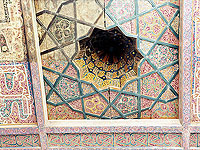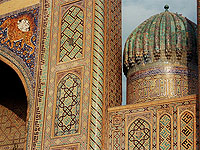 |
|
Uzbekistan - Milestones of History |
|||
|
Especially, Bukhara saw its rise during the Samanids as the gathering place for the great scholars and literary men of the time. The city was famous for its library "Siwan al hikma" ("The Storehouse of wisdom"), used by Avicenna. In the second half of the 10th century the Samanid dynasty entered its phase of shake-ups taking place due to separatist moves on the part of local rulers. Thus, the support of the local elite towards Samanid rule began to gradually diminish, leading to its full dissolution. In 999 the Ghaznavis and Karakhanids established their reign in the region. The latter subdued the vast territories stretching from inside districts of China to the Amu Darya River. Within the Karakhanid Kingdom, the settled and semi-nomadic population used to prevail in the Khorezm and Tashkent oases, Ferghana, and partly on the territory of ancient Sogdiana. By the early 13th century, Khorezm became one of the largest states in the East. Irrigation prospered and the number of big cities rose in the state. Its capital - Kokhna-Urgench (Old Urgench) was famous for its handicraft industry. However the internal class war weakened the state sufficiently enough, leading to the invasion by the Mongols led by Genghis Khan. By 1221, the whole of Central Asia fell to the reign of Genghis Khan. Cities were destroyed, irrigation systems crushed, hundreds of thousands of people were killed and taken prisoner of war. Following the death of Genghis Khan in 1227, Central Asia along with the area of Seven Rivers, and Eastern Turkestan made up the so - called ulus, or the land possessions ruled by the sovereign. As such, was appointed the second son of Genghis Khan, Chagatai, but the ulus was actually led by Makhmud Yalavach. The decade of the 40s of the 14th century saw the disintegration of the Chagatai ulus into several states. The split and internal wars became worse and cruder. Taking advantage of the situation, in the second half of the 14th century, the great Amir Temur (Tamerlane) came on the scene (1336 4405). Having joined the divided territories of Central Asia, Amir Temur created a powerful state with its capital in Samarkand. In 1380 Amir Temur launched military campaigns to other countries. As a result, Iran, Trans-Caucasus, Iraq, Syria, Turkey, Northern India, and others were conquered. Amir Temur governed the vast country through his sons, grandsons, and confidants by appointing them as rulers in different regions and countries. The establishment of a centralized country in the region paved the way for the development of economy broken apart by the rule of the Mongols. Also, agriculture prospered, as well as craftsmanship, internal and external trade. The living standards of the people were on the rise. Samarkand, especially, changed for the better very much. Talented artists, architects, and scholars from various countries worked and lived in the capital, Besides, the city became a unique center for both cultural and scientific development that dictated the fashion in art, handicraft, architecture, poetry, literature, music, and celebration of festivals and performances. Thanks to his political power and goals, Amir Temur revived and improved the institutions of state, as well as social and military administration. The brilliant rise of science, architecture, town planning, literature, both fine and applied arts represent this unique period. Following the death of Amir Temur, his state broke up into two. The one in Khorasan with its center in Herat led by his son, Shokhrukh, and another in Maverannakhr (the area between two rivers, the Syr Darya and the Amu Darya; now Central Asia) - with its center in Samarkand, and led by Shokhrukh's son - Ulughbek, as well as other small areas, also ruled by the Temur descendants. The borders of Ulughbek's state almost coincide with those of present day Uzbekistan, Ulughbek is known as a great medieval scientist-astronomer, both organizer and patron of science and the arts. |

